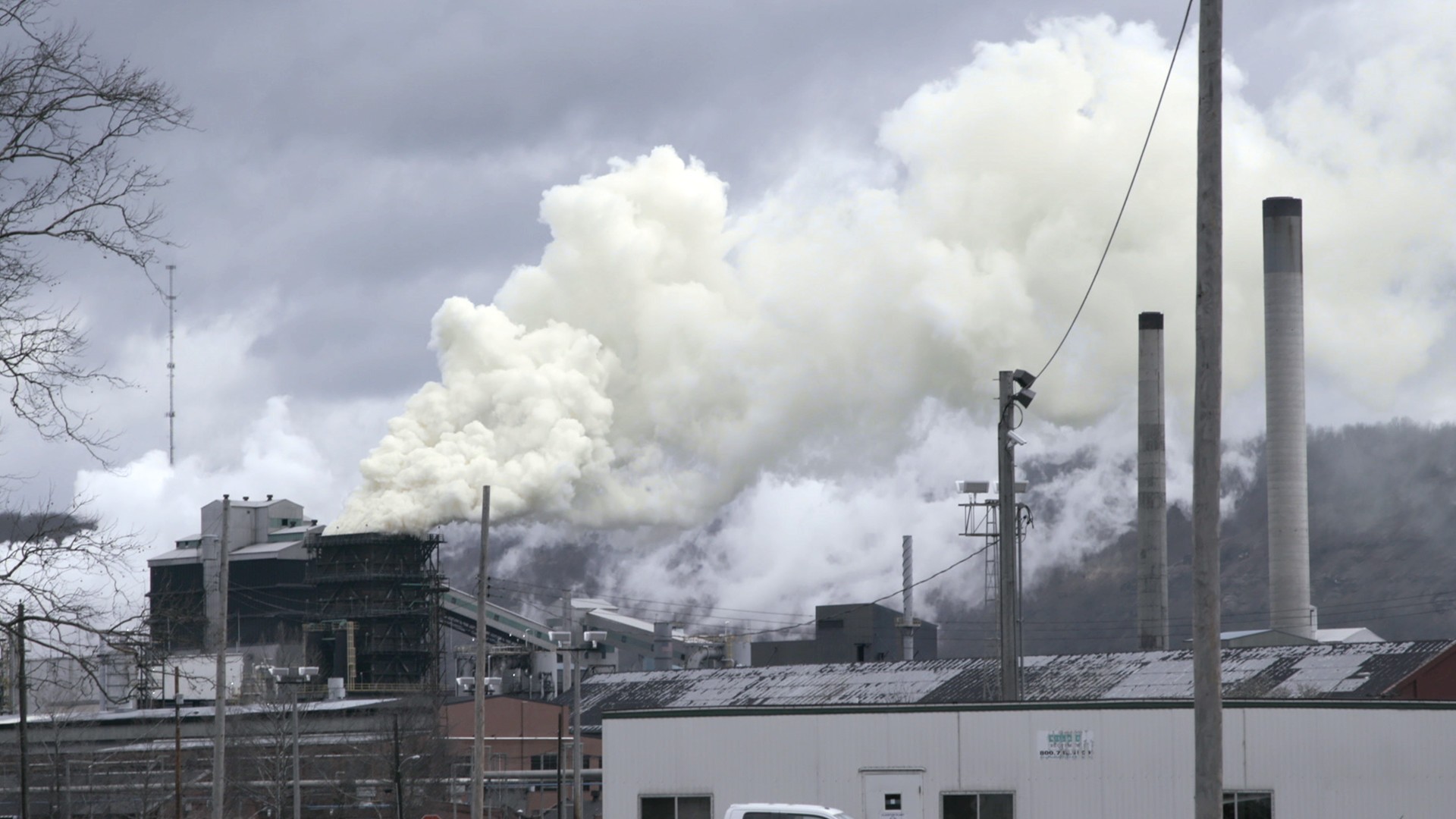A worker at a Louisville Ford plant. Photo by Luke Sharrett/Bloomberg via Getty Images
I heard this joke on a tour of an old Oakland theater: The guide was talking about how, after a renovation, workers carried a bulky, antique couch up two flights of stairs. "They said it used to take six workers to bring up the couch," she said. "But now with the union, it takes eight." The crowd murmured a half-chuckle, prompting the guide to explain it further. "It's because they're lazy," she said, and everyone laughed.It was an innocuous moment, quickly forgotten. But the underlying stereotype is a problem labor union organizers have to deal with. A Pew survey from earlier this year found that while more Americans look favorably upon labor unions than they have since 2002, only 11 percent of the country's workers belong to one, the lowest rate since 1983. That means most people only know about unions secondhand—from popular culture, news stories, and even jokes.There's little mystery why union membership is so low. For decades, the right has engaged in attacks on unions, a traditional Democratic constituency. Most recently, a case scheduled to be heard by the Supreme Court could cripple public sector unions by not requiring non-members represented by unions in collective bargaining agreements to pay dues.*

Those who believe that unions are the best way for workers to improve their conditions have to fight against Republican-backed "right to work" laws and a presidential administration that talks constantly about "workers" but rarely mentions unions. But they also have to contend with perceptions that union workers are lazy, entitled, or corrupt—an attitude that makes union-killing regulations easy for the general public to stomach."What's remarkable is that the portrayal hasn't changed much over the decades," said Nelson Lichtenstein, director of the Center for the Study of Work, Labor, and Democracy at UC Santa Barbara. He brought up the term "labor boss," a derisive title made popular by progressives in the 1920s and 30s. "On the one hand, they'd call [monopolists like] John D. Rockefeller a 'robber baron,' and on the other, a labor union head was a 'boss.'"The reason for the dual-sided attack was the perception that both sides were trying to thwart the harmony of the free market, a mentality that's led to the same queasy feeling some market-oriented liberals today have for unions. "They think that if the market worked the way it should, that'd be perfect," said Lichtenstein. "But unions are not for the market. They're against the market. That's the purpose of a union."

To Lichtenstein, this broad American anti-union ideology was cemented in 1957, when Teamsters head Jimmy Hoffa was brought before the Senate during the famed McClellan Committee on Improper Activities in Labor and Management. That image of the corrupt Hoffa testifying before Congress has remained the cultural representation of labor unions. "He's been dead for 40 years, and he's still the face of labor," said Lichtenstein.Real-world union-corruption scandals from past decades have stayed in the collective consciousness thanks to pop culture. "It could be as farfetched as my dad told me unions are bad, to something like, I watch The Sopranos, or now The Deuce, and all union members are crooks and trying to defraud their employer," said Don Barker, organizing director of the International Association of Machinists and Aerospace Workers (IAM), a union with nearly 700,000 members throughout North America. "When you're running only 10 to 12 percent union [membership] nationally, it's easy to portray whatever you want."Coverage of unions often doesn't help. Christopher R. Martin, author of Framed! Labor and Corporate Media, a 2003 book about the mainstream media's anti-labor bias, partially blames anti-union sentiment on a shift in media markets in the 1970s. According to him, the spread of television in the 60s fractured audiences just as independent newspapers began to be publicly traded, leading to a crisis of advertisement income. Publishers tried to counter this by developing audiences who had money, meaning the families that'd moved from cities to the suburbs. Papers no longer worried so much about the lower-income communities still crowded in the cities.Anti-union bias in news coverage is usually subtle rather than overt, and can be as simple as the framing of a story. To take one example: In 2000, bus and rail drivers for the LA Metropolitan Transportation Agency went on strike. The opening paragraph in the ABC News story covering the action wasn't about worker demands, but about the "hundreds of thousands of people" who wouldn't be able to get where they wanted to go. "The first thing you see is people angry because they can't fly or whatever, and [the strikers] are the troublemakers," Martin told me. "Labor is seen as self-centered, greedy, and impolite to the rest of the consumers."Inside unions, these perceptions don't matter as much. "We don't talk Democrat or Republican—we talk values," said Yvonne Walker, president of Service Employees International Union Local 1000, a California-based chapter with 95,000 members. "Do you believe everyone should have access to healthcare? Yes? So, let's work on that. And when politicians come through, our members are asking, 'How are you going to use your office to address systemic racism?' Or, 'How are you going to change the wage gap between men and women?'"Union members may have a good understanding of those values and the benefits they receive through collective bargaining, but what about those who aren't in a union? How can unions educate them about, say, the problems with anti-union laws being pushed by Republicans?As president of SEIU 1000, Walker has urged union members to introduce "alternative messaging" when talking to members of their community or family, at events or even just across the dinner table. This idea is based on polls suggesting that while people react negatively to job descriptions like "state worker," they have better reactions when the job itself is explained. "Instead of saying 'I'm a water technician,' you say, 'My job is to make sure when you turn on the faucet, your water is drinkable,'" said Walker. "Or 'I inspect the bridges, to make sure when you drive across, it's going to be safe.'"To me, this sounds a lot like fuzzy VHS-era "joke reel" parody of an old AFSCME commercial: "We pick up your fuckin' garbage… We plug up the holes in the roads so you don't fuck up your car."So far, 2017 has not been a good year for unions. Though there were high-profile campaigns to unionize digital media companies (including VICE Media) and raise the minimum wage to $15, some major organizing efforts in the manufacturing sector fell flat. In February, workers at Boeing in South Carolina rejected a vote for unionization. In August, a Nissan workers in Mississippi similarly voted not to unionize—in both cases after extremely contentious campaigns from both organizers and management. Organizers say this is normal, and remain upbeat. "It's not uncommon to take more than one election to get there," said Barker. "It's a process of education, and sometimes take two, three, four times to get everyone on the same page."One piece of good news for unions is the striking disconnect between generations in how they are viewed—a poll in 2015 showed that 57 percent of millennials think of unions positively, versus only 41 percent of baby boomers. Maybe that's because memories of unions as corrupt are finally fading. Maybe young people are more open to left-wing politics. Or, it could be that, in today's era of income stagnation and freelance gigs replacing careers with benefits, millennials recognize that they may need to band together in order to secure a piece of the economic pie.As Walker put it, "Unions are the last bastion of working people having the opportunity to collectivize their voice." That's not as funny as jokes about lazy Teamsters, but it's a lot more true.This article has been updated to more accurately describe the upcoming Supreme Court case.Follow Rick Paulas on Twitter.
Advertisement

Those who believe that unions are the best way for workers to improve their conditions have to fight against Republican-backed "right to work" laws and a presidential administration that talks constantly about "workers" but rarely mentions unions. But they also have to contend with perceptions that union workers are lazy, entitled, or corrupt—an attitude that makes union-killing regulations easy for the general public to stomach."What's remarkable is that the portrayal hasn't changed much over the decades," said Nelson Lichtenstein, director of the Center for the Study of Work, Labor, and Democracy at UC Santa Barbara. He brought up the term "labor boss," a derisive title made popular by progressives in the 1920s and 30s. "On the one hand, they'd call [monopolists like] John D. Rockefeller a 'robber baron,' and on the other, a labor union head was a 'boss.'"
Advertisement

To Lichtenstein, this broad American anti-union ideology was cemented in 1957, when Teamsters head Jimmy Hoffa was brought before the Senate during the famed McClellan Committee on Improper Activities in Labor and Management. That image of the corrupt Hoffa testifying before Congress has remained the cultural representation of labor unions. "He's been dead for 40 years, and he's still the face of labor," said Lichtenstein.Real-world union-corruption scandals from past decades have stayed in the collective consciousness thanks to pop culture. "It could be as farfetched as my dad told me unions are bad, to something like, I watch The Sopranos, or now The Deuce, and all union members are crooks and trying to defraud their employer," said Don Barker, organizing director of the International Association of Machinists and Aerospace Workers (IAM), a union with nearly 700,000 members throughout North America. "When you're running only 10 to 12 percent union [membership] nationally, it's easy to portray whatever you want."
Advertisement
Advertisement
